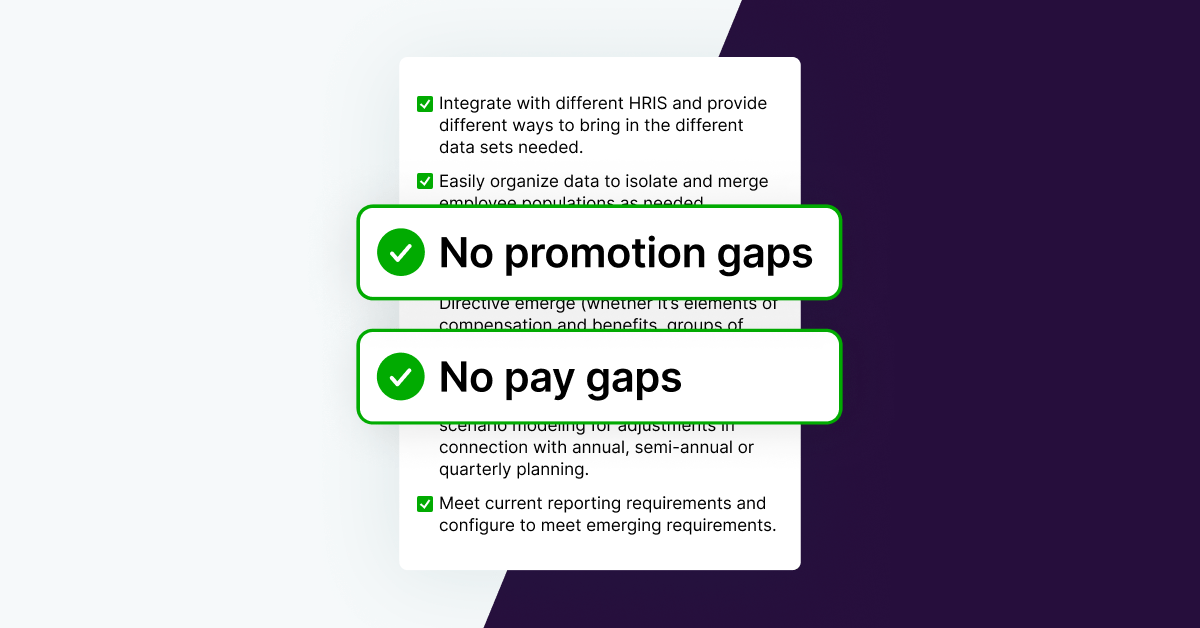With the EU pay transparency directive looming, many multinational companies are wondering how they should move forward with pay equity strategies and communication. The directive itself, which will likely take effect in 2024, is designed to address the gender pay gap across the European Union that stands at around 13%, with significant variations among member states — and it has decreased only minimally over the last ten years.
The EU’s broad sweeping proposed pay regulations are the result of a global cross-pollination of regulatory trends between Europe and the United States. Some concepts, such as a focus on the median pay gap and on representation metrics, as well as public reporting, have migrated from Europe to the U.S. On the other hand, the U.S. has inspired a rise in litigation as the enforcement mechanism, pay secrecy prohibitions, salary history bans, and pay scale transparency in Europe. The directive would replace and/or supplement the current “patchwork quilt” of existing laws in European countries.
What does the new EU pay directive require?
As a result of this cross-pollination, the directive includes five requirements. You can review the full directive here, but these are the key points:
- Equal pay for work of comparative value: Employers must establish tools and appropriate methodologies to compare work of comparable value with objective criteria;
- Transparency in pay and career progression: Requires pay scale disclosure in job postings or at interviews; bans salary history requests; requires employers to provide criteria for career progression;
- Right to information: Employees can request individual pay level and average pay levels, broken down by sex, for categories of workers doing the same work or work of equal value; employers must inform employees of this right on an annual basis and allow employees to request the information through a representative or equality body; and employers are banned from using pay secrecy confidentiality clauses;
- Pay reporting: Employers with 50+ employees (reduced from the 250+ originally proposed) must report publicly on their pay gaps, including base pay and “any other consideration”; must report on pay level, pay gap (mean), median pay level, median pay gap, quartile pay gap, and gap based on equal pay for equal work (not public). See an explanation of the difference between “pay equity” and the “pay gap.”
- Joint pay assessment: If a company’s average pay gap is at least 2.5% in any category (reduced from the 5% originally proposed), which is not justified by objective and gender-neutral factors, the employer must do a pay assessment in all groups, in coordination with works council or representative; and if the pay gap cannot be justified, must take remedial action.
As a first step, we believe that companies need to figure out their underlying compensation philosophy, then use their data to understand exactly which factors drive pay. This is accomplished with data analytics to understand both the percentage of variation in compensation explained by pay policies as well as the question of “by how much policies impact pay?” Once a company understands these threshold matters, it will be better positioned to disclose pay ranges as required by the directive. It is critical to be able to explain to applicants and employees why their compensation varies between X and Y so they understand that their compensation is based on objective, consistent, fair and equitable factors such as years of experience, education, or location (as examples).
Running robust, ongoing analyses empowers organizations to be confident and less timid about being transparent about compensation, and increases the likelihood that your organization will see the benefits of it. Next, explain your pay policies and how they impact pay so that business managers understand these things and can effectively communicate about these issues to employees.
Start with the high level: the vision and the philosophy. Then move into tactical actions: analyzing data, training managers, and then continuously evaluating the data and output to make sure issues don’t arise as models drift when people and compensation changes over time.
Who are the right stakeholders to include in these high-level conversations?
It is critical to involve the right constellation of stakeholders to be successful in preparing for the new regulations going into effect. This is very often much broader than HR. For most organizations, this will include functional leaders in the organization, including business leaders. Representation from all functions, regions, and cultures will help ensure that there are no surprises, and that there is sufficient buy-in before implementation. Avoiding siloed conversations can be challenging for some organizations, but we are advocates of putting in the work to create robust partnerships between HR and other functions to optimize the chances of success in initiatives like this.
What are the effects when employers are transparent about things like pay ranges and the pay gap?
With good preparation, pay transparency can provide a lot of benefits to the employee value proposition (EVP) of a company and to a journey of creating a “people first” culture. But increasing transparency around pay and pay gaps also has the potential for some negative consequences if we don’t plan for and mitigate them.
If managers don’t fully understand the compensation structure and the data, and they’re not able to deliver it effectively to employees, that can negatively impact employee trust. If managers answer vaguely, employees may feel insecure, which can be worse than not saying anything at all. But that is an issue that can readily be addressed with training for managers.
Another issue that can arise is offering transparency without building enough channels for employees to communicate, ask questions, and express feedback. That can create frustration for the employees, so be sure to address that need.
Finally, if companies haven’t audited the data well before presenting it, they may inadvertently spotlight existing discrepancies. So be extremely careful to make sure data are credible and any necessary remediation has been planned ahead of time.
How should companies communicate their pay equity status and strategies?
Organizations should always communicate clearly whenever they send broad communications on any topic, explaining why they’re doing this, why this is happening, and what it means for you. But in addition to this broader communication, managers will be the first line of communication whenever it comes to employees. As we mentioned above, managers have a big role to play in this and leadership has a big role to play in making sure managers are comfortable in relaying this information. We need to equip them with the right skills.
Provide your managers not only with the basic info and an understanding of the data, but also with the skills to have these difficult conversations. Not every manager today has the skill to be able to answer difficult questions; that requires a soft skill upskilling, not just information around rewards and compensation.
In general, keeping things simple is going to help. Also, try to make your HR systems as objective as possible, so that it’s easy to explain and you don’t get tangled up in subjective issues and debates.
Recommended action steps to prepare for EU pay regulations
Finally, there are five action steps we recommend to prepare for and comply with the EU directive. These include:
- Adopt a continuous improvement mindset.
What this really means is start with the data. The data will help you understand what issues you have, and the root causes. From there, step by step on a daily basis, start making small improvements to get to where you want to be. Live the pay transparency journey as a continuous improvement journey. - Demystify pay and simplify.
The second thing is to demystify and simplify, which you do as you’re going through the journey, as you are training, communicating, providing information and supporting your people.Leaders try to simplify things because explaining things clearly goes a long way in terms of building trust. When things are clear and simple to understand, people are more likely to trust. It creates a certain level of safety.You want to come to a point where pay is no longer the secret HR topic that only HR knows about, irrespective of where you end up in the pay transparency spectrum. Even if you don’t share salaries of all employees, let it become a topic that is not taboo to discuss. - Focus on the human framework EVP.
Whatever you do, don’t forget your final objective throughout this pay transparency journey — and it might be a long journey. Take a step back and remember why you’re doing this: You want to create a powerful employee value proposition in your company. Pay transparency is one aspect that is helping you to grow your EVP and reinforce your EVP. Don’t forget that.It’s important to note, as you’re working on pay transparency, that it’s not about completing the checklist and saying, “Okay, we’ve been transparent on X, Y and Z. That’s what was mandated by the regulation.” Instead, your objective is to make your employees feel that pay is equitable in their company, that they are treated fairly, and that they work for a compliant company with integrity. - Look before you leap.
Start now — don’t wait. 2024 is around the corner. There are steps organizations need to take to be successful. Start by understanding your company’s pay philosophy and its approach at a fundamental level in order to inform how you build the rest of these processes. That is something you need to start doing right now.You’ve got to look at your data, you’ve got to implement technology to start evaluating where you’re at now, and to get all those things we described above in a row. - Find the right balance for your organization between minimalist compliance and full transparency.
Get the right stakeholders together to start understanding what is the right balance for your organization on this spectrum that ranges from a minimal amount of transparency, based on what’s required, to greater transparency. By focusing on this now, you’ll be able to get ahead and be prepared for regulatory changes.
This is a short summary of a webinar we recently presented to discuss the new EU pay regulations and how we believe companies should plan to meet them. Watch the recording at your convenience to hear the full discussion.
This blog post is a quick guide about the European pay transparency directive, but always consult with your counsel about how to ensure compliance. Syndio does not provide legal advice or guidance. All information, content, and materials are provided for general informational purposes only. Links to third-party or government websites are offered for the convenience of the reader; Syndio is not responsible for the content on linked pages.


